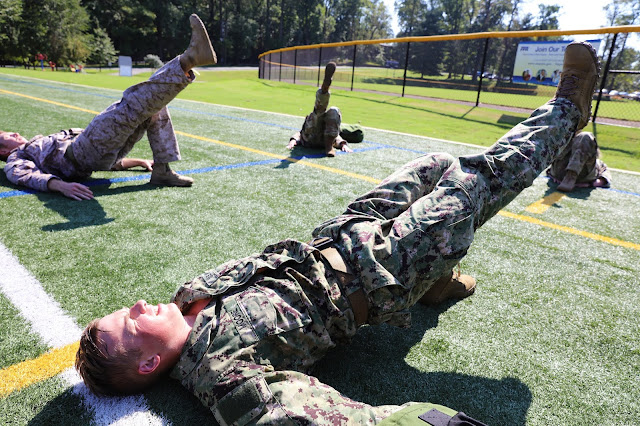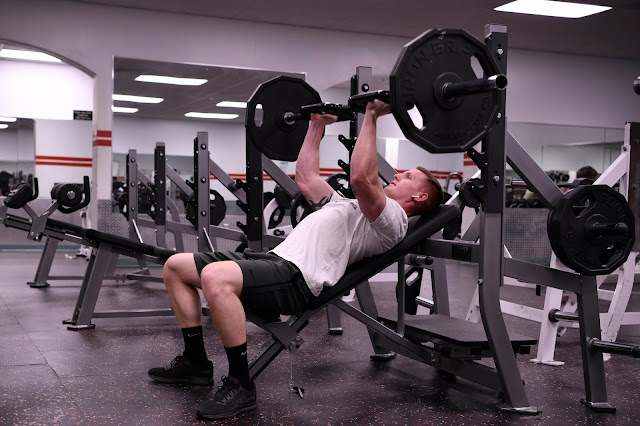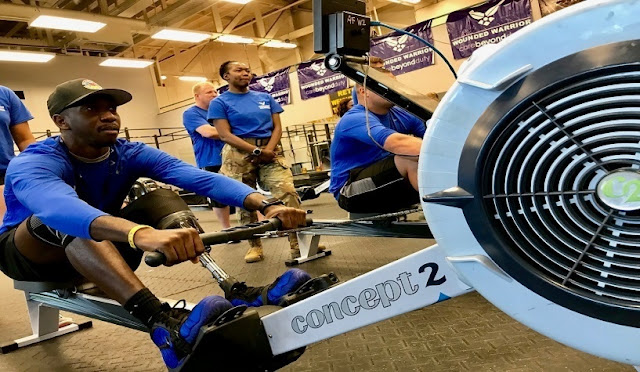Making Better Service Members through Operational Fitness
Photo by Sarah Marshall
Uniformed Services University
In the early morning darkness, before many people in the Washington, D.C., area are even out of bed, a group of military officers dressed in camouflage rapidly make their way to the end of a field behind the Uniformed Services University of the Health Sciences in Bethesda, Md. Armed with sledgehammers, they move with a purpose, focused completely on the mission at hand.
The group’s leader, Army 2ndLt Joshua Sullivan, tells them to stop. The cold air meets the heat of their bodies, creating an eerie steam that resembles a fog that blankets the area around them. As they catch their breath, Sullivan pulls out his cell phone to check for instructions, momentarily lighting up the pitch blackness surrounding the joint service team.
“Combat sprints, 3 rounds,” he says. The students sprint back down the field, sledgehammer in tow, dropping to the prone position after each 25-meter length and resting one minute before repeating it two more times.
The team has performed these movements many times before. In fact, they meet several times a week under the cover of darkness or during the lunch hour as part of the students’ Operational Fitness (OPFIT) group.
The brainchild of Sullivan, a former enlisted Special Forces medic, the OPFIT group was started two years ago as a way to maintain fitness, readiness, and sanity while juggling the demands of medical school.
“I started it as a workout group. We take lessons learned from our careers and keep the mindset of being operational and turn that into a successful fitness program. It helps us keep our sanity outside of the books and gives us an outlet,” Sullivan said.
He started the group during his first year in medical school. Sullivan said he sent out “feelers” and got some positive responses from his classmates, so he set up workouts several times a week – primarily at 6 a.m. before school, but also during the lunch hour to accommodate those who are unable to start before dawn.
Many of the exercises are designed around the personal experiences of Sullivan and others during deployment. One of the workouts is called “Afghan village” because it’s based on a real-life scenario Sullivan encountered on deployment in Afghanistan. After his unit was ambushed and several of his fellow soldiers were injured, Sullivan and his team had to treat and carry three casualties to the casualty evacuation site for medevac, then run back to the target with additional equipment to complete the mission, while under fire. The workout incorporates exercises that mimic those same movements – sprinting, dropping to a prone position, buddy-carrying each other, lunge walking while carrying a 60 lb. sandbag, and then a final sandbag carry up a steep embankment, all while wearing their 20 lb. vest, advanced combat helmet, and carrying a sledgehammer.
“We use the mindset of ‘what will make us stronger as combat medics.’ We focus on legs, core, lifting people or things, and endurance. Everyone is issued a vest, helmet, and a sledgehammer that simulates carrying the weight of an M4 rifle. It’s functional fitness, which makes us better soldiers, sailors, and airmen, and combat physicians.” Sullivan said.
The program has caught on. On any given day, Sullivan will be joined by a dedicated group of 8-12 of his first- and second-year medical school classmates. He says there is an “ebb and flow of participants” and while he knows it’s not a lot of people because the routines are very difficult workouts, those who do come out understand the impact and are committed and motivated. “We’re not just working out – it’s about building a mindset.”
Sullivan’s classmates, Army 2nd Lt. A.J. Folsom, a former Special Forces Team Leader, and Army 2nd Lt. Will Glazer, a former Ranger medic, have also designed workouts based on their experiences as special operators. The trio get a lot of satisfaction in seeing their classmates develop, grow and become stronger – both physically and mentally.
Some of the other workouts include a sandbag run – holding a 40-60 pound bag filled with sand above their heads, while running, tossing it, picking it up, and repeating the action multiple times for 10 minutes. Most of the exercise scenarios take place on the field behind USU, but they have also included stair climbs – repeatedly running up and down 10 flights of stairs in one of the nearby parking garages – and over the creek and through the woods behind USU, navigating logs and other natural obstacles.
Army 2nd Lt. Molly Lonneman is a regular participant in the Operational Fitness workouts. Lonneman, a former collegiate swimmer with no prior military service, is “a great athlete,” said Sullivan, “but the workouts were tough for her at first. Now she is one of the best athletes out there.”
“I joined for a couple of reasons. I have always valued fitness and tried to make that a consistent part of my daily routine, however, I recognized that my motivation for going to the gym and actually getting a good workout done had declined slightly in my last years of college. I was worried that I would fall into the trap of ‘being too busy to workout’ during med school, and OPFIT offered a fantastic solution. I was drawn to the fact that OPFIT is such a positive atmosphere that also offers me some great accountability in my workouts. I was also interested in the functional fitness aspects of the workouts as I had never done anything like that before,” Lonneman said.
“We keep a spreadsheet of all the workouts we've done over the past year so that everyone can track their progress. Looking back on that I can really appreciate how much my fitness has improved since starting OPFIT,” Lonneman continued. “I know I've made a lot of progress in my strength, endurance and cardiovascular fitness, especially from a functional standpoint.”
Sullivan is inspired by the students’ “no quit” mentality. Army 2nd Lt. Vidya Lala, who also had no prior service before coming to USU, has “made huge improvements,” according to Sullivan, since she joined the Operational Fitness group. He said she frequently talks to Sullivan, Folsom and Glazier about where their motivation comes from and how they keep going mentally and spiritually.
Sullivan said a lot of that motivation comes from veterans. “It’s kind of cheesy,” he said, “but we start out every workout by reading a poem from the book, ‘War Poetry’. There are poems that span everything from the Greeks through Vietnam, WWII, and more that are written by modern soldiers. It gives us the mindset of why we’re here,” Sullivan said.
Navy Ensign Carolyn Gibbons, a second-year medical student at USU, is also a regular participant in the Operational Fitness sessions.
“OPFIT is important to me for several reasons: for one, working out with a close group of people who constantly push me keeps me sane; it is a great stress reliever. But, more importantly, it keeps me in check. Most of the workouts are inspired by experiences from Josh's time as a Special Forces medic and he will occasionally share stories that make you appreciate just how much our brothers and sisters in arms endure. In my future career as a military doc, it's not likely that I will ever be running through a fire-fight, throwing injured over my shoulder or climbing a mountain to provide care, but I will not disregard the fact that there was a team of people who went through extreme circumstances to get their buddy to care,” she said. “I push myself to and beyond my limits physically to try to comprehend the demands on those for whom I care and so that if there is ever a situation in which I must be capable of great strength or endurance to save lives I am ready. While our jobs are vastly different, I believe military doctors should hold themselves to the same physical standards as the service members we care for and be ready for any situation.
“Second, I really enjoy the camaraderie, the competitiveness, and the purpose,” Gibbons continued. “Everyone pushes themselves and each other at every workout; there is no slacking off or taking it easy and you're better for it after every workout.”
The group is there rain, shine, hot or cold. “Several weeks last year it was bitter cold, but we kept meeting and working out,” Sullivan said.
On this day, as the clock approaches 6:45 a.m., the steam from their strenuous activity continues to emanate from each of the students and they work to regulate their breathing. Sullivan calls them all together.
“Who’s ready for the Jane Fondas?” Sullivan says, referring to a set of hip-strengthening cool-down exercises reminiscent of the popular Jane Fonda Workout of the 1980s. The group forms into a circle, each one lying on their side, slowly raising and lowering their leg, cooling down until the steam dissipates. Sullivan checks the timer on his phone and thanks everyone for coming out. After a quick shower, it’s time for school to start.
“One of the reasons I chose USU for med school was its unique mission to treat and care for America's military members,” said Lonneman. “Although I will likely spend the majority of my career in a hospital setting, I think it is important for me to maintain my own personal fitness. OPFIT gives me the chance to appreciate what other members of the military (my future patients) do on a day to day basis while challenging me both physically and mentally to be the toughest med student I can be.”
“It [OPFIT] gives me extreme confidence in my future colleagues. I know that the people who are a part of OPFIT are determined, hard-working people who don't give up and that's the kind of doctor I want working beside me and caring for my family,” said Gibbons. “Every other workout team I've been a part of has been for individual fulfillment, to stay in shape and have fun. But, OPFIT's purpose is selfless, its origin and goals are about something much bigger than any one of us; it’s rooted in being your best so you can serve others and so there is nothing you can't handle when someone's life might be on the line.”




Comments
Post a Comment